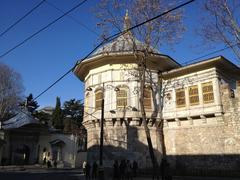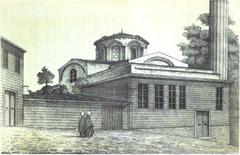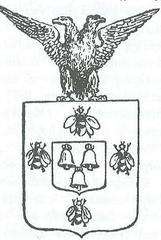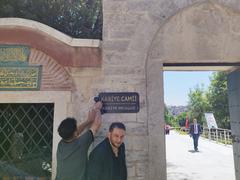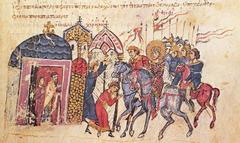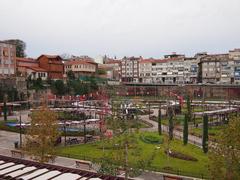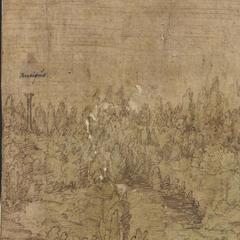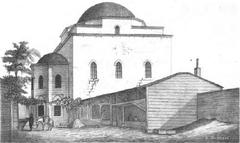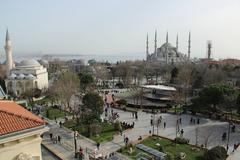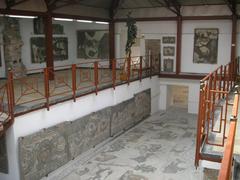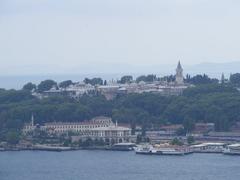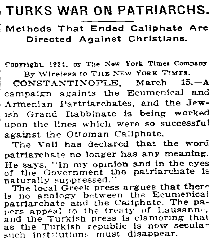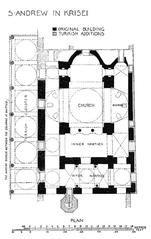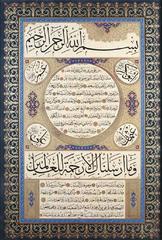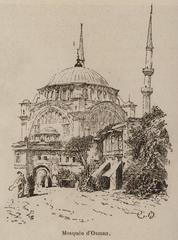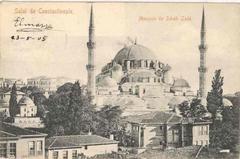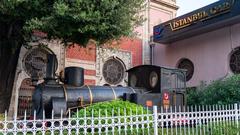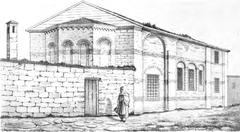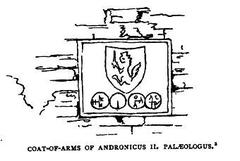
Mausoleum of Mahmud II: Visiting Hours, Tickets, and Historical Site Guide in Istanbul
Date: 03/07/2025
Introduction
The Mausoleum of Mahmud II, located in Istanbul’s historic Fatih district, is a testament to the transformative legacy of Sultan Mahmud II and a masterpiece of late Ottoman architecture. This guide provides a comprehensive overview of the mausoleum’s historical context, architectural features, cultural significance, and practical information for visitors—including updated visiting hours, ticket details, accessibility, and nearby attractions. Whether you are a history enthusiast, architecture lover, or cultural traveler, this guide will help you make the most of your visit to one of Istanbul’s most significant imperial landmarks. For authoritative details, consult resources such as the Istanbul Tourism Portal and learn more about Mahmud II’s legacy.
Table of Contents
- Origins and Construction of the Mausoleum
- Sultan Mahmud II: Legacy and Reforms
- Architectural Features and Symbolism
- The Royal Necropolis: Burials and Significance
- Historical and Urban Context
- Visitor Information: Hours, Tickets, and Accessibility
- Cultural and Political Legacy
- Preservation and Modern-Day Relevance
- Frequently Asked Questions (FAQ)
- Visuals and Media
- Internal and External Resources
- Conclusion & Travel Tips
Origins and Construction of the Mausoleum
Commissioned by Sultan Abdülmecid I in 1840 to honor his father, the Mausoleum of Mahmud II was designed by the renowned Armenian-Ottoman architects Hovannes and Boğos Dadyan. Its location on Divanyolu Street in Çemberlitaş—formerly the heart of the Ottoman capital—was made possible by land donated by Esma Sultan, Mahmud II’s sister (Wikipedia; turkiyeworld.com; nomadicniko.com). Completed in 1840, the mausoleum represents the Ottoman Empire’s architectural transition during the Tanzimat era, fusing classical Ottoman and emerging European neoclassical elements (visitingistanbul.com).
Sultan Mahmud II: Legacy and Reforms
Sultan Mahmud II (r. 1808–1839) is best known as a reformist ruler whose policies reshaped the Ottoman Empire. His most significant act was the dissolution of the Janissary Corps in 1826—known as the Auspicious Incident—which enabled sweeping military and administrative reforms (Wikipedia; wikiwand.com). Mahmud II reduced the power of provincial governors, abolished the Court of Confiscations, and introduced legal, fiscal, and educational reforms that paved the way for the Tanzimat modernization period (Encyclopaedia Britannica). Despite territorial losses and internal strife, his reign marked the beginning of the empire’s transformation toward a centralized, modern state.
Architectural Features and Symbolism
The mausoleum is an outstanding example of 19th-century Ottoman funerary architecture, harmonizing Ottoman traditions with neoclassical motifs (turkiyeworld.com). The octagonal plan symbolizes eternity and the celestial, while the grand marble dome, relief garlands, and floral motifs evoke both spiritual and imperial themes. The façade features pilasters, cornices, and arched windows adorned with stone tracery and tilework, blending European influences with Ottoman artistry (istanbulsite.com).
Notable interior elements include:
- A crystal chandelier gifted by Queen Victoria, reflecting growing diplomatic ties with Europe.
- Two French clocks presented by Napoleon III.
- Gilded calligraphic inscriptions and intricate frescoes depicting the sultan’s achievements.
- Stained glass windows that illuminate the chamber with vibrant colors (evendo.com).
The mausoleum complex also includes a mosque, fountain, auxiliary structures, and a tranquil garden with cypress trees—symbols of immortality.
The Royal Necropolis: Burials and Significance
The mausoleum is the final resting place for Sultan Mahmud II and numerous members of the Ottoman dynasty, including:
- Sultan Abdülaziz (brother)
- Sultan Abdülhamid II (son)
- Bezmiâlem Valide Sultan (Mahmud II’s wife)
- Several daughters and royal consorts (kulturenvanteri.com)
This concentration of royal burials underlines the mausoleum’s dynastic importance, serving as a symbol of imperial continuity and reverence.
Historical and Urban Context
Located on Divanyolu Street—once the ceremonial avenue linking the palace to religious and administrative centers—the mausoleum is at the heart of Istanbul’s historical urban fabric (evendo.com). Its proximity to landmarks such as the Blue Mosque, Sultanahmet Square, and the Grand Bazaar makes it an essential stop for visitors exploring the city’s Ottoman heritage (turkiyeworld.com).
Visitor Information: Hours, Tickets, and Accessibility
Visiting Hours
- Open: Tuesday to Sunday, 9:00 AM – 5:00 PM
- Closed: Mondays and certain national/religious holidays
(Always confirm current hours on the official Istanbul Tourism Portal before visiting.)
Tickets and Admission
- Entrance: Free of charge
- Donations: Welcomed to support conservation
- Guided Tours: Available on-site and through select tour operators; recommended for in-depth historical context
Accessibility
- Wheelchair Access: Partially accessible; the garden and main entrance are navigable, but some interior areas have steps or uneven flooring
- Facilities: Restrooms available at the neighboring Fatih Mosque complex
- Assistance: Staff support available on request
Travel Tips
- Dress Code: Modest attire required; women should cover their heads, arms, and legs (scarves are available at the entrance)
- Shoes: Must be removed before entering the mausoleum
- Photography: Permitted (no flash inside)
- Best Time to Visit: Early mornings or late afternoons, especially in spring or autumn for optimal lighting and fewer crowds
- Nearby Attractions: The Fatih Mosque (Fatih Mosque Istanbul), Blue Mosque, Sultanahmet Square, Grand Bazaar
Cultural and Political Legacy
The Mausoleum of Mahmud II is not just a historical monument—it is a symbol of the Ottoman Empire’s modernization and the cultural synthesis of the Tanzimat era (Wikipedia). Its architecture, inscriptions, and associated ceremonies reflect the evolving nature of Ottoman identity, statecraft, and religious tradition.
Preservation and Modern-Day Relevance
Significant restoration initiatives—led by the Turkish Ministry of Culture and Tourism and local authorities—have preserved the mausoleum’s structural and artistic integrity (Istanbul Metropolitan Municipality). These efforts ensure accessibility, safety, and educational value for future generations. The site remains a locus for commemorations, educational programs, and cultural events (Istanbul Tourism Portal).
Frequently Asked Questions (FAQ)
What are the visiting hours?
Tuesday–Sunday, 9:00 AM–5:00 PM; closed Mondays and some holidays.
Is there an entrance fee?
No, admission is free; donations are appreciated.
Are guided tours available?
Yes, on-site and via tour operators.
Is the mausoleum accessible for wheelchairs?
Partially—gardens and main entrance are accessible; some interior steps may present challenges.
Can I take photos inside?
Yes, but without flash and with respect for the site’s religious and memorial nature.
How do I get there?
Located in the Fatih district, accessible by tram (Aksaray stop), bus, taxi, or on foot from major city landmarks.
Visuals and Media
- High-quality images: [Tomb of Mahmud II Istanbul exterior view], [Interior frescoes of Mahmud II Mausoleum], [Crystal chandelier], [Garden surrounding the tomb]
- Virtual tours and maps available on official tourism websites and istanbulsite.com
Internal and External Resources
Conclusion & Travel Tips
The Mausoleum of Mahmud II is a profound symbol of Istanbul’s imperial past and a living monument to the city’s ongoing cultural vibrancy. Its architectural grandeur, historical resonance, and serene atmosphere make it an essential stop for any visitor seeking to understand the Ottoman Empire’s final centuries and the roots of modern Turkey. Plan your visit to include this site in your Istanbul itinerary, and take time to explore the surrounding Fatih district for a truly immersive cultural experience.
Travel Smart:
- Confirm hours online before your visit
- Dress respectfully and observe local customs
- Consider a guided tour for deeper historical context
- Download the Audiala app for guided audio experiences and insider tips
For more information, see istanbulsite.com and the official municipal pages.
References
- Wikipedia: Tomb of Mahmud II
- turkiyeworld.com
- nomadicniko.com
- visitingistanbul.com
- wikiwand.com
- evendo.com
- kulturenvanteri.com
- istanbulsite.com
- Istanbul Tourism Portal
- Istanbul Metropolitan Municipality
- Encyclopaedia Britannica: Mahmud II
- Istanbul Tourist Information: Fatih Mosque Istanbul


